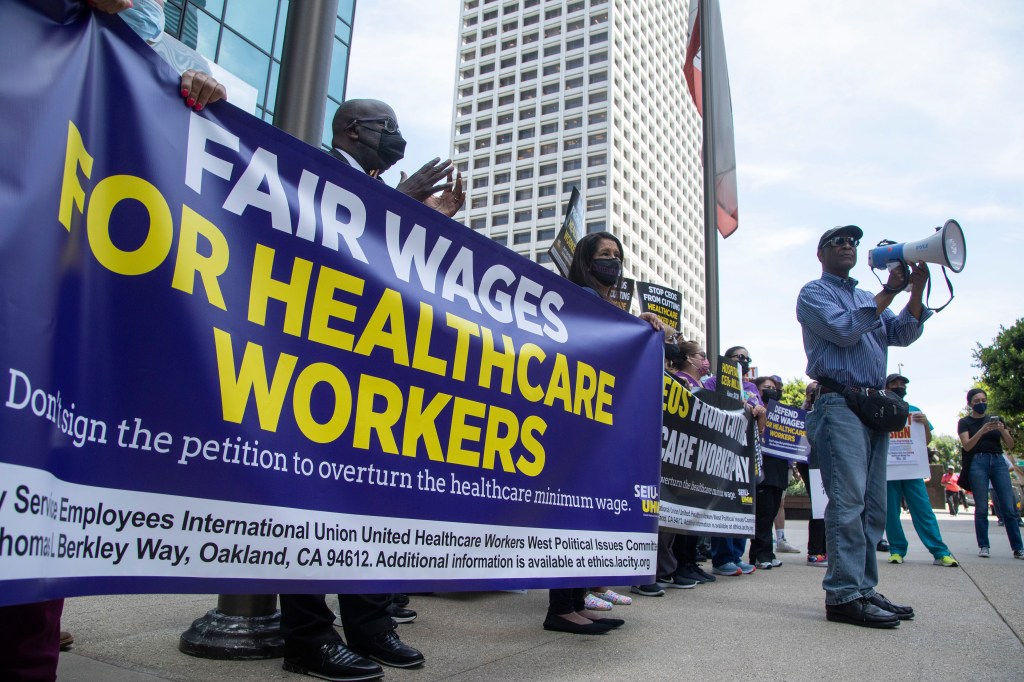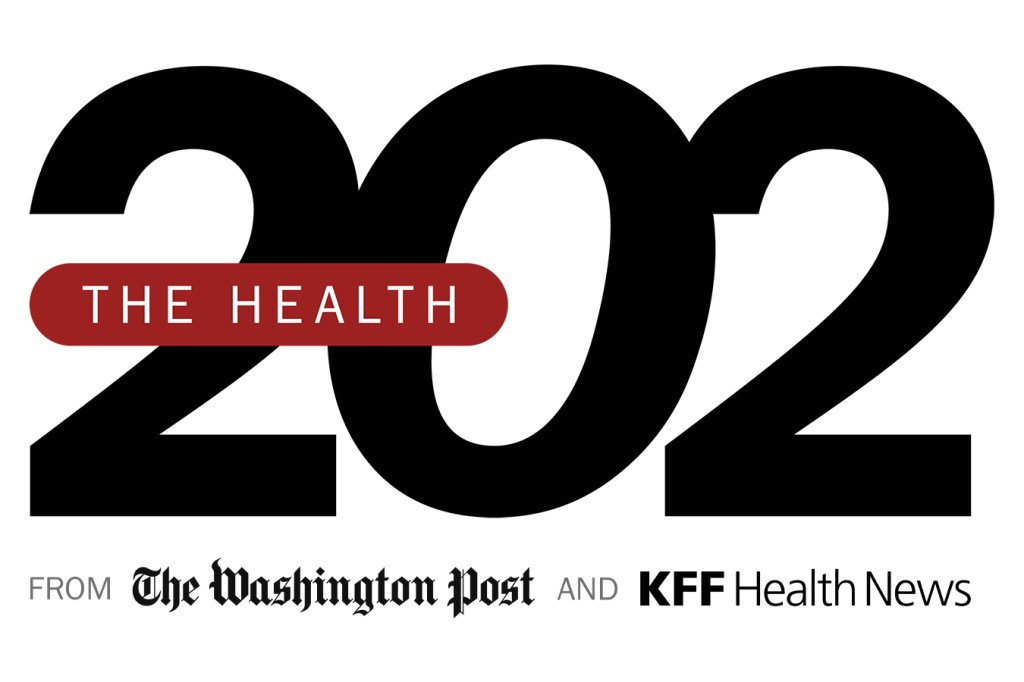— Nearly a half-million health workers who stand to benefit from California’s nation-leading $25 minimum wage law could be in for a rude awakening if hospitals and other health care providers follow through on potential cuts to hours and benefits.
A medical industry challenge to a new minimum wage ordinance in one Southern California city suggests layoffs and reductions in hours and benefits, including cuts to premium pay and vacation time, could be one result of a state law set to begin phasing in in June. However, some experts are skeptical of that possibility.
The California Hospital Association brought a partly successful legal challenge to Inglewood’s $25 minimum wage ordinance, which barred employers from taking those sorts of steps to offset their higher costs.
“Layoffs, reductions in premium pay rates, reductions in non-wage benefits, reductions in hours, and increased charges are consequences of an employer having less money to spend—which will necessarily be the case given the significant increase in spending on wages due to the minimum wage,” the association said in its lawsuit. Additional examples include reducing health coverage and charging for parking or work-related equipment.
Inglewood voters approved the ordinance in November 2022, nearly a year before California legislators enacted a $25 minimum wage for health workers. Those statewide higher wages are to be phased in starting in June under California’s first-in-the-nation law, but Gov. Gavin Newsom has since said they are too expensive as the state faces a deficit estimated between $38 billion and $73 billion. It’s unclear if lawmakers will agree to a delay or take other steps to reduce the cost.
U.S. District Judge Dale S. Fischer agreed with the hospital industry in a March 11 tentative ruling when he shot down the portion of Inglewood’s ordinance banning layoffs and clawbacks by employers, while allowing the rest of the ordinance to remain in effect. He gave the sides time to object to his preliminary decision, though none did.
The California Hospital Association represents more than 400 hospitals and was a key backer of the state’s carefully crafted compromise law, which notably contains none of the employee safeguards included in the Inglewood ordinance.
Spokesperson Jan Emerson-Shea said the association doesn’t know how providers will react once the state law takes effect. “We don’t have any insights,” she said.
“The challenge for any health care organization is figuring out how to pay for the higher wages,” said Joanne Spetz, director of the Philip R. Lee Institute for Health Policy Studies at the University of California-San Francisco. “Since labor costs are the largest part of any health care organization’s costs, it’s hard to figure out how to reduce spending without looking at labor costs.”
Providers can try to increase revenues by bargaining for higher reimbursements from commercial insurers, she said. Public hospitals, nursing homes, and community clinics get most of their money through Medi-Cal, the state’s Medicaid program.
Providers could reduce the services they offer, pare back charity care, and cut or delay capital investments, Spetz said. In the long term, she expects some combination of spending cuts and revenue increases.
Both the state law and local ordinance cover far more than doctors and nurses, with a definition of health worker that includes janitors, housekeepers, groundskeepers, security guards, food service workers, laundry workers, and clerical staff.
The most recent estimate by the Health Care Program at the University of California-Berkeley Labor Center is that as many as 426,000 health workers would make an average of $6,400 extra in the law’s first year, a 19% average pay bump mainly benefiting lower-income workers of color and women. State finance officials project that well over 500,000 workers will benefit.
Researchers didn’t include layoffs and other potential staffing and benefit reductions when they projected the state law’s costs and benefits, said Laurel Lucia, the program’s director. But she pointed to initial projections by hospitals, doctors, and business and taxpayer groups that the wage hike would cost $8 billion annually, thereby imperiling services and resulting in higher premiums and higher costs for state and local governments.
“It seems like a contradiction to say this law’s going to cost billions of dollars while at the same time saying it’s going to reduce workers’ total compensation,” said Lucia, who projects a far lower price tag.
She added that state finance officials had anticipated that Medi-Cal reimbursements would reflect the increased labor costs, while Medicare would eventually at least partially compensate for the higher labor costs.
Michael Reich, chair of the Center on Wage and Employment Dynamics at UC Berkeley’s Institute for Research on Labor and Employment, and affiliated economist Justin Wiltshire recently argued that California’s new $20 minimum wage law for fast-food workers won’t result in mass layoffs and price increases, as some have predicted.
Health care is much different than fast food, Reich acknowledged, but he argued for much the same positive result.
“A higher minimum wage will make it easier and cheaper for hospitals to recruit and retain these workers. The cost savings, and the productivity benefits of more experienced workers, could offset much of the labor cost increase,” Reich said.
The hospital association filed its lawsuit against Inglewood’s ordinance in July, while it was still opposing early versions of the statewide minimum wage legislation. Among many other provisions, the statewide law put on hold an initiative to cap hospital executives’ salaries in Los Angeles.
The hospital association’s legal challenge referenced in part layoffs and reduced working hours imposed by Centinela Hospital Medical Center after Inglewood’s ordinance took effect.
But Centinela said the reduction was entirely unrelated to the ordinance and that all staff were offered alternate positions, which many accepted.
“Centinela Hospital also has since added many more jobs in new clinical positions above minimum wage scale,” the hospital said in a statement.
Service Employees International Union-United Healthcare Workers West, the prime backer of both the local ordinance and the statewide law, sued the hospital in April 2023 alleging that it cut workers’ hours to offset the higher minimum wage. The case is still pending.
The union did not respond to repeated requests for comment.
In a court filing, however, the union and city of Inglewood said similar employer restrictions in previous minimum wage laws have survived.
The ordinance “merely sets the backdrop for collective bargaining negotiations,” and does not bar employers from locking out employees or hiring replacement workers during a strike. Employers can still lay off workers or reduce their hours, they said, so long as they don’t do so to fund the higher minimum wage.
But Fischer agreed with the hospital association that layoffs and reductions in employees’ total compensation packages are “obvious responses by an employer to rising compensation costs.”
Restricting employers’ options would violate federal labor relations rules, he said.
“The minimum wage an employer has to pay its employees will invariably affect the total amount of compensation it is able or willing to pay,” he wrote “This will then invariably affect the number of employees it can retain and the number of hours those employees will be scheduled to work.”
This article was produced by KFF Health News, which publishes California Healthline, an editorially independent service of the California Health Care Foundation.
KFF Health News is a national newsroom that produces in-depth journalism about health issues and is one of the core operating programs at KFF—an independent source of health policy research, polling, and journalism. Learn more about KFF.
USE OUR CONTENT
This story can be republished for free (details).






